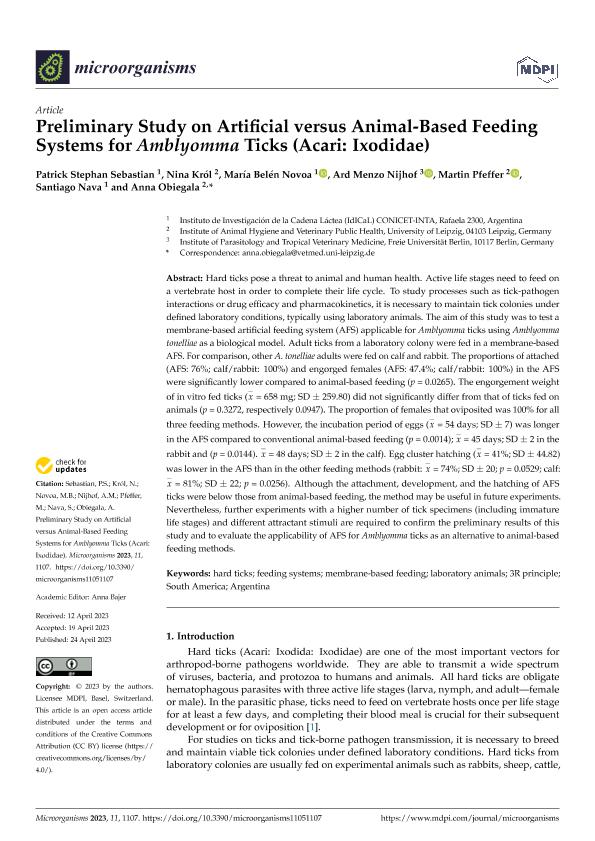Mostrar el registro sencillo del ítem
dc.contributor.author
Sebastian, Patrick Stephan

dc.contributor.author
Król, Nina
dc.contributor.author
Novoa, María Belén

dc.contributor.author
Nijhof, Ard Menzo
dc.contributor.author
Pfeffer, Martin
dc.contributor.author
Nava, Santiago

dc.contributor.author
Obiegala, Anna
dc.date.available
2024-02-05T12:56:29Z
dc.date.issued
2023-04
dc.identifier.citation
Sebastian, Patrick Stephan; Król, Nina; Novoa, María Belén; Nijhof, Ard Menzo; Pfeffer, Martin; et al.; Preliminary Study on Artificial versus Animal-Based Feeding Systems for Amblyomma Ticks (Acari: Ixodidae); MDPI; Microorganisms; 11; 5; 4-2023; 1-10
dc.identifier.issn
2076-2607
dc.identifier.uri
http://hdl.handle.net/11336/225715
dc.description.abstract
Hard ticks pose a threat to animal and human health. Active life stages need to feed on a vertebrate host in order to complete their life cycle. To study processes such as tick-pathogen interactions or drug efficacy and pharmacokinetics, it is necessary to maintain tick colonies under defined laboratory conditions, typically using laboratory animals. The aim of this study was to test a membrane-based artificial feeding system (AFS) applicable for Amblyomma ticks using Amblyomma tonelliae as a biological model. Adult ticks from a laboratory colony were fed in a membrane-based AFS. For comparison, other A. tonelliae adults were fed on calf and rabbit. The proportions of attached (AFS: 76%; calf/rabbit: 100%) and engorged females (AFS: 47.4%; calf/rabbit: 100%) in the AFS were significantly lower compared to animal-based feeding (p = 0.0265). The engorgement weight of in vitro fed ticks ((Formula presented.) = 658 mg; SD ± 259.80) did not significantly differ from that of ticks fed on animals (p = 0.3272, respectively 0.0947). The proportion of females that oviposited was 100% for all three feeding methods. However, the incubation period of eggs ((Formula presented.) = 54 days; SD ± 7) was longer in the AFS compared to conventional animal-based feeding (p = 0.0014); (Formula presented.) = 45 days; SD ± 2 in the rabbit and (p = 0.0144). (Formula presented.) = 48 days; SD ± 2 in the calf). Egg cluster hatching ((Formula presented.) = 41%; SD ± 44.82) was lower in the AFS than in the other feeding methods (rabbit: (Formula presented.) = 74%; SD ± 20; p = 0.0529; calf: (Formula presented.) = 81%; SD ± 22; p = 0.0256). Although the attachment, development, and the hatching of AFS ticks were below those from animal-based feeding, the method may be useful in future experiments. Nevertheless, further experiments with a higher number of tick specimens (including immature life stages) and different attractant stimuli are required to confirm the preliminary results of this study and to evaluate the applicability of AFS for Amblyomma ticks as an alternative to animal-based feeding methods.
dc.format
application/pdf
dc.language.iso
eng
dc.publisher
MDPI
dc.rights
info:eu-repo/semantics/openAccess
dc.rights.uri
https://creativecommons.org/licenses/by/2.5/ar/
dc.subject
3R PRINCIPLE
dc.subject
ARGENTINA
dc.subject
FEEDING SYSTEMS
dc.subject
HARD TICKS
dc.subject
LABORATORY ANIMALS
dc.subject
MEMBRANE-BASED FEEDING
dc.subject
SOUTH AMERICA
dc.subject.classification
Ciencias Veterinarias

dc.subject.classification
Ciencias Veterinarias

dc.subject.classification
CIENCIAS AGRÍCOLAS

dc.title
Preliminary Study on Artificial versus Animal-Based Feeding Systems for Amblyomma Ticks (Acari: Ixodidae)
dc.type
info:eu-repo/semantics/article
dc.type
info:ar-repo/semantics/artículo
dc.type
info:eu-repo/semantics/publishedVersion
dc.date.updated
2024-02-02T15:37:28Z
dc.journal.volume
11
dc.journal.number
5
dc.journal.pagination
1-10
dc.journal.pais
Suiza

dc.journal.ciudad
Basel
dc.description.fil
Fil: Sebastian, Patrick Stephan. Consejo Nacional de Investigaciones Cientificas y Tecnicas. Centro Cientifico Tecnologico Conicet - Santa Fe. Instituto de Investigacion de la Cadena Lactea. - Instituto Nacional de Tecnologia Agropecuaria. Centro Regional Santa Fe. Estacion Experimental Agropecuaria Rafaela. Instituto de Investigacion de la Cadena Lactea.; Argentina
dc.description.fil
Fil: Król, Nina. Universitat Leipzig; Alemania
dc.description.fil
Fil: Novoa, María Belén. Consejo Nacional de Investigaciones Cientificas y Tecnicas. Centro Cientifico Tecnologico Conicet - Santa Fe. Instituto de Investigacion de la Cadena Lactea. - Instituto Nacional de Tecnologia Agropecuaria. Centro Regional Santa Fe. Estacion Experimental Agropecuaria Rafaela. Instituto de Investigacion de la Cadena Lactea.; Argentina
dc.description.fil
Fil: Nijhof, Ard Menzo. Freie Universität Berlin; Alemania
dc.description.fil
Fil: Pfeffer, Martin. Universitat Leipzig; Alemania
dc.description.fil
Fil: Nava, Santiago. Consejo Nacional de Investigaciones Cientificas y Tecnicas. Centro Cientifico Tecnologico Conicet - Santa Fe. Instituto de Investigacion de la Cadena Lactea. - Instituto Nacional de Tecnologia Agropecuaria. Centro Regional Santa Fe. Estacion Experimental Agropecuaria Rafaela. Instituto de Investigacion de la Cadena Lactea.; Argentina
dc.description.fil
Fil: Obiegala, Anna. Universitat Leipzig; Alemania
dc.journal.title
Microorganisms
dc.relation.alternativeid
info:eu-repo/semantics/altIdentifier/url/https://www.mdpi.com/2076-2607/11/5/1107
dc.relation.alternativeid
info:eu-repo/semantics/altIdentifier/doi/http://dx.doi.org/10.3390/microorganisms11051107
Archivos asociados
